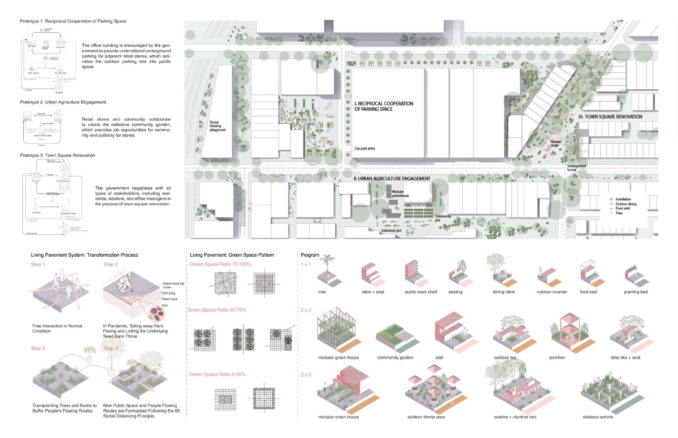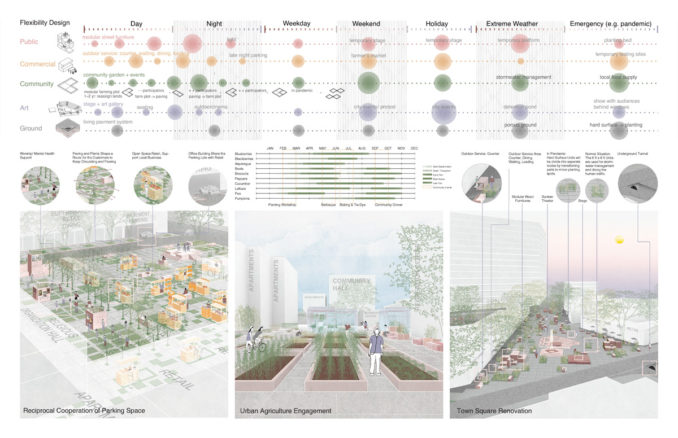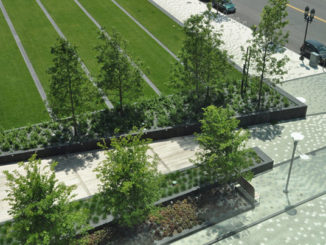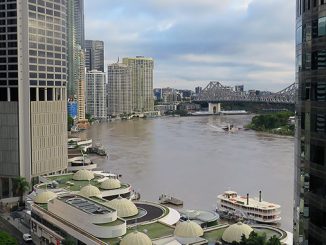Runner Up in the Reimagining the Spaces In Between Student Ideas Competition.

LIVING GROUND explores the potentials of the specific scale raised to public attention by the pandemic: six feet distancing. Our team investigates different scenarios that occupy 6ft * 6ft unit space and beyond. The project uses a grid system to offer both a sense of distance and a way to organize programs on the site. Currently, activities are centralized and programmed in urban public space, and the lack of collaboration between different institutions leads to the rigid separation of various programs. The project reflects the significance of landscape architecture in making urban spaces and explores the future of urban space with flexibility and resilience.
The plan promotes different levels of sociability and guarantees high flexibility. The public open spaces are decentralized and fragmented, providing spaces for community congregation and small group retreat. Our living pavement system enables the flexible organization of space that adapts to various circumstances. Seeds are stored in the bottom layer of each paving unit. In areas with less circulation or in cases where social distancing is needed, the top layer can be dismantled, allowing plants to grow and become a buffer between people. The plants also absorb rainwater and provide stormwater management in case of intense precipitation.
A series of installations are developed according to the grid system. The installation is composed of the basic unit of a square. The community is encouraged to assemble and utilize the installation facility according to their needs, such as seating, playground, bookshelves, stage, or planters.
LIVING GROUND calls for collaboration and exchange of resources between different social groups, allowing flexible use of space. The following are the three prototypes of col- laboration that drive the three main social areas.

Prototype 1: Reciprocal Cooperation of Parking Space
The office building is encouraged by the government to provide underutilized underground parking for nearby retail stores, which activates the outdoor parking lots into public space. The freed-up space set the ground for open space markets. The green pavings regulate a circulation route for customers. Outdoor seating and dining spaces are accommodated along with the sites, to provide safe distancing for in-situ social activities during the pandemic. This parking lot space exchange returns the office build- ings with commercial profits, which formulate reciprocal cooperation between diverse institutions.
Prototype 2: Urban Agriculture Engagement
Retail stores and communities collaborate to create the collective community garden, which provides job opportunities for community and publicity for stores. The commu- nity garden includes individual plots, community plots, and modular greenhouses, allowing different modes of productivity. The modular green-house and individual plots can be easily built and extended according to needs. In the case of a pandemic, the government can encourage the communities to expand the gardens for local food supply.
Prototype 3: Town Square Renovation
The government negotiates with all types of stakeholders, including residents, retailers, and office managers in the process of town square renovation. The existing “Rose Street” is transformed into an underground tunnel to provide a continuous pedestrian-friendly surface for tourists and improve the accessibility for the residents. The town square accommodates various activities, visualizing people as city profiles. A sunken stage is installed on the square so that people can display themselves at the center of city identity.
LIVING GROUND
Entry Credit: Xi (Echo) Chen, Sufeng (Sophia) Xiao, Xuezhen (Esther) Xie, Siqi (Joyce) Zhu – Graduate School of Design, Harvard University; CALS – Cornell University
Image and Text Credit: Xi (Echo) Chen, Sufeng (Sophia) Xiao, Xuezhen (Esther) Xie, Siqi (Joyce) Zhu – Graduate School of Design, Harvard University; CALS – Cornell University



